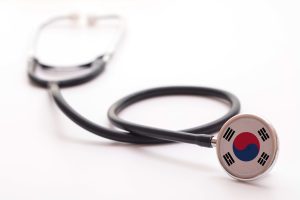Going to the hospital is no doubt a grueling experience in and of itself. Going to one in South Korea is no exception, accompanied by hours of waiting for a few minutes of facetime. For context, there are 2.5 physicians per 1,000 people in South Korea – far below the OECD average of 3.7. In that mix are those practicing Korean medicine, trained to administer acupuncture and esoteric concoctions. Cross them out, and the figure dips to 2. On an ordinary day, one Korean physician deals with 58 patients.
Yet the annual number of newly licensed physicians has remained the same for almost two decades, because college spots for medical degrees are capped at around 3,000. Former President Moon Jae-in tried and failed to ratchet it up by 400 back in 2020. In protest of the proposal, doctors went on strikes – in the middle of the COVID-19 pandemic.
The Korea Medical Association (KMA), a trade union for doctors, has resisted calls for an increased supply of white gowns and other health reforms deemed as hurting their interests.
Their logic is rather straightforward and transparent: strangle the supply of their services to jack up their compensation. An average Korean physician earns approximately $177,000 a year, almost twice as much as the OECD average. Hospitals in remote areas even offer physicians they need up to $700,000 a year. Doctors are in such short supply that it’s common for nurses to cover for them by drafting prescriptions and conducting minor surgeries, all of which only doctors are authorized to do.
Yet, a series of mishaps for the past few months has galvanized the public and brought the issue back into the limelight. Last August, a nurse on duty collapsed from a brain hemorrhage. At her work, however, there were no doctors who could operate on her, so she was transferred to a different hospital where she died.
Then in March, a teenager fell from a building. A string of hospitals shooed her ambulance away, saying they were glutted with patients and surgeons were unavailable. She died in the roaming ambulance.
In May, a feverish five-year-old couldn’t receive timely treatment due to a lack of pediatricians in the first four hospitals the ambulance contacted. The child died a few days later. The same month, a septuagenarian run over by a car died in an ambulance after two hours of hospital-hopping. Ten hospitals rejected him.
The public reaction is one of visceral rage, precisely because these horror stories could happen to anyone. Collectively, the events represent a chronic shortage of physicians in such fields as emergency care, cardiothoracic surgery, internal medicine, pediatrics, and neurosurgery – those where life or death hinges on a tiniest delay.
Simultaneously, these incidents all happened in big cities where people believed medical infrastructure was sufficient. That suggests things are way worse in the countryside, bearing higher amenable mortality, or the number of deaths that could have been prevented by opportune medical care.
From 2018 to 2022, there were some 37,000 cases in which hospitals turned away ambulances. One-third of those rejections were caused by the lack of relevant physicians. On average, only half of critically ill patients receive timely care. In particular, around 40 percent of those struck with cerebral infarction – where every second counts – fail to procure immediate care from the first hospital they reach.
The overall shortage of physicians is mostly to blame. Adding to the crisis, of the few doctors there are, many opt to open private practices in the most lucrative fields such as dermatology, plastic surgery, and ophthalmology. More than 80 percent of surgeons once slated for work in major hospitals are now running their own practices to treat largely cosmetic ailments unrelated to their specialties.
As the South Korean society ages rapidly, demand for medical services is expected to surge. The Korea Institute for Health and Social Affairs estimates that by 2035 South Korea will face a shortage of 27,000 physicians. Thus the government decided to roll up its sleeves.
The Yoon administration announced a reform plan on May 18 to increase the college quota for medical degrees to 3,500 – a 16 percent increase – starting from the academic year of 2025. It also pledged on June 5 to hammer out a more sophisticated triage system and bonus schemes that can better reward physicians charged with taxing work.
On the contrary, the KMA maintains that their paltry medical corps suffices – talk of expanding their rank is considered a taboo among the doctors. Rebuffing the reform to enlarge their pool, they tout their top-notch healthcare technology and the easy medical accessibility enjoyed by South Koreans. The problem, they say, is not the number of physicians, but the push factors prompting their exodus from demanding fields. (Still, some of these factors, such as inordinate work stress and responsibility associated with surgery, are merely an integral part and the inherent nature of saving lives.)
Just like in 2020, the government’s proposed reform could very well be thwarted. In May, the KMA had already browbeat the government – by threatening a national strike that could have risked patients’ lives – to scrap legislation that aimed to protect nurses from overwork and legalize the scope of their indispensable services.
On June 9, the Health Ministry urged the KMA to accept the government’s wish to increase the number of physicians and to draw up a rubric for a negotiation in the near future. Meanwhile, the ruling People Power Party is treading carefully, as “we need to take into account the possibility of the doctors refusing to treat patients” in defiance.
Much fuming and mudslinging are on the horizon, but the sick don’t have much time to spare.
































